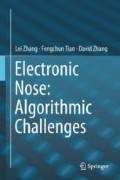Abstract
This chapter presents a novel domain correction and adaptive extreme learning machines framework (DC-AELM) with transferring capability to solve the drift and interference problem of E-nose. The framework consists of two parts: (1) domain correction (DC) that makes the distributions of two domains close; (2) adaptive extreme learning machine (AELM) that learns a transferable classifier at decision level. This method is motivated by the idea of transfer learning, especially from the perspective of domain correction and decision making, to realize the knowledge transfer for interference suppression and drift compensation. Experiments on a background interference dataset and a public benchmark sensor drift dataset via E-nose verify the effectiveness of the proposed DC-AELM method.
Access this chapter
Tax calculation will be finalised at checkout
Purchases are for personal use only
References
J. Feng, F. Tian, J. Yan, Q. He, Y. Shen, L. Pan, A background elimination method based on wavelet transform in wound infection detection by electronic nose. Sens. Actuators, B Chem. 157(2), 395–400 (2011)
S. Marco, A. Gutierrez-Galvez, Signal and data processing for machine olfaction and chemical sensing: a review. IEEE Sens. J. 12(11), 3189–3214 (2012)
G. Korotcenkov, B.K. Cho, Instability of metal oxide-based conductometric gas sensors and approaches to stability improvement (short survey). Sens. Actuators, B Chem. 156(2), 527–538 (2011)
S.D. Carlo, M. Falasconi, Drift correction methods for gas chemical sensors in artificial olfaction systems: techniques and challenges. Adv. Chem. Sens. (2012). https://doi.org/10.5772/33411
T. Artursson, T. Eklöv, I. Lundström et al., Drift correction for gas sensors using multivariate methods. J. Chemometr. 14, 711–723 (2012)
F. Tian, J. Yan, S. Xu, J. Feng, Background interference elimination in wound infection detection by electronic nose based on reference vector-based independent component analysis. Inf. Technol. J. 11(7), 850–858 (2012)
O. Tomic, H. Ulmer, J.E. Haugen, Standardization methods for handling instrument related signal shift in gas-sensor array measurement data. Anal. Chim. Acta 472, 99–111 (2002)
C.D. Natale, E. Martinelli, A.D. Amico, Counteraction of environmental disturbances of electronic nose data by independent component analysis. Sens. Actuators, B Chem. 82, 158–165 (2002)
J. Feng, F. Tian, P. Jia, Q. He, Y. Shen, S. Fan, Improving the performance of electronic nose for wound infection detection using orthogonal signal correction and particle swarm optimization. Sens. Rev. 34(4), 389–395 (2014)
M. Padilla, A. Perera, I. Montoliu, A. Chaudry, K. Persaud, S. Marco, Drift compensation of gas sensor array data by orthogonal signal correction. Chemometr. Intell. Lab. Syst. 100(1), 28–35 (2010)
M. Zuppa, C. Distante, P. Siciliano, K.C. Persaud, Drift counteraction with multiple self-organising maps for an electronic nose. Sens. Actuators, B Chem. 98(2), 305–317 (2004)
S.D. Vito, G. Fattoruso, M. Pardo et al., Semi-supervised learning techniques in artificial olfaction: a novel approach to classification problems and drift counteraction. IEEE Sens. J. 12(11), 3215–3224 (2012)
A. Vergara, S. Vembu, T. Ayhan, M.A. Ryan, M.L. Homer, R. Huerta, Chemical gas sensor drift compensation using classifier ensembles. Sens. Actuators, B Chem. 167, 320–329 (2012)
E. Martinelli, G. Magna, A. Vergara, C.D. Natale, Cooperative classifiers for reconfigurable sensor arrays. Sens. Actuators, B Chem. 199, 83–92 (2014)
E. Martinelli, G. Magna, S.D. Vito, R.D. Fuccio, G.D. Francia, A. Vergara, C.D. Natale, An adaptive classification model based on the artificial immune system for chemical sensor drift mitigation. Sens. Actuators, B Chem. 177, 1017–1026 (2013)
A.C. Romain, J. Nicolas, Long term stability of metal oxide-based gas sensors for e-nose environmental applications: an overview. Sens. Actuators, B Chem. 146(9), 502–506 (2010)
L. Zhang, F. Tian, S. Liu, L. Dang, X. Peng, X. Yin, Chaotic time series prediction of E-nose sensor drift in embedded phase space. Sens. Actuators, B Chem. 182(1), 71–79 (2013)
D.A.P. Daniel, K. Thangavel, R. Manavalan, R.S.C. Boss, ELM-Based Ensemble Classifier for Gas Sensor Array Drift Dataset (Springer, India, 2014). https://doi.org/10.1007/978-81-322-1680-3_10
S.J. Pan, Q. Yang, A survey on transfer learning. IEEE Educ. Activities Dept. 22(10), 1345–1359 (2010)
K. Yan, D. Zhang, Correcting instrumental variation and time-varying drift: a transfer learning approach with autoencoders. IEEE Trans. Instrum. Meas. 65(9), 2012–2022 (2016)
K. Yan, D. Zhang, Improving the transfer ability of prediction models for electronic noses. Sens. Actuators, B Chem. 220, 115–124 (2015)
L. Zhang, Y. Liu, P. Deng, Odor recognition in multiple e-nose systems with cross-domain discriminative subspace learning. IEEE Trans. Instrum. Meas. (2017). https://doi.org/10.1109/TIM.2017.2669818
L. Zhang, D. Zhang, Domain adaptation extreme learning machines for drift compensation in e-nose systems. IEEE Trans. Instrum. Meas. 64(7), 1790–1801 (2015)
K. Yan, D. Zhang, Calibration transfer and drift compensation of e-noses via coupled task learning. Sens. Actuators, B Chem. 225, 288–297 (2016)
G. Huang, Q. Zhu, C. Siew, Extreme learning machine: theory and applications. Neurocomputing 70(1), 489–501 (2006)
G. Feng, G.B. Huang, Q. Lin, R. Gay, Error minimized extreme learning machine with growth of hidden nodes and incremental learning. IEEE Trans. Neural Netw. 20(8), 1352–1357 (2009)
G.B. Huang, H. Zhou, X. Ding, R. Zhang, Extreme learning machine for regression and multiclass classification. IEEE Trans. Syst. Man Cybern. Part B 42(2), 513–529 (2012)
W. Zong, G.B. Huang, Y. Chen, Weighted extreme learning machine for imbalance learning. Neurocomputing 101(3), 229–242 (2013)
Z. Bai, G.B. Huang, D. Wang, H. Wang, M.B. Westover, Sparse extreme learning machine for classification. IEEE Trans. Cybern. 44(10), 1858–1870 (2014)
X. Li, W. Mao, W. Jiang, Fast sparse approximation of extreme learning machine. Neurocomputing 128(5), 96–103 (2014)
G. Huang, S. Song, J.N. Gupta, C. Wu, Semi-supervised and unsupervised extreme learning machines. IEEE Trans. Cybern. 44(12), 2405–2417 (2014)
L. Zhang, F. Tian, C. Kadri et al., On-line sensor calibration transfer among electronic nose instruments for monitoring volatile organic chemicals in indoor air quality. Sens. Actuators, B Chem. 160(1), 899–909 (2011)
Author information
Authors and Affiliations
Rights and permissions
Copyright information
© 2018 Springer Nature Singapore Pte Ltd.
About this chapter
Cite this chapter
Zhang, L., Tian, F., Zhang, D. (2018). Domain Correction-Based Adaptive Extreme Learning Machine. In: Electronic Nose: Algorithmic Challenges. Springer, Singapore. https://doi.org/10.1007/978-981-13-2167-2_13
Download citation
DOI: https://doi.org/10.1007/978-981-13-2167-2_13
Published:
Publisher Name: Springer, Singapore
Print ISBN: 978-981-13-2166-5
Online ISBN: 978-981-13-2167-2
eBook Packages: Computer ScienceComputer Science (R0)

